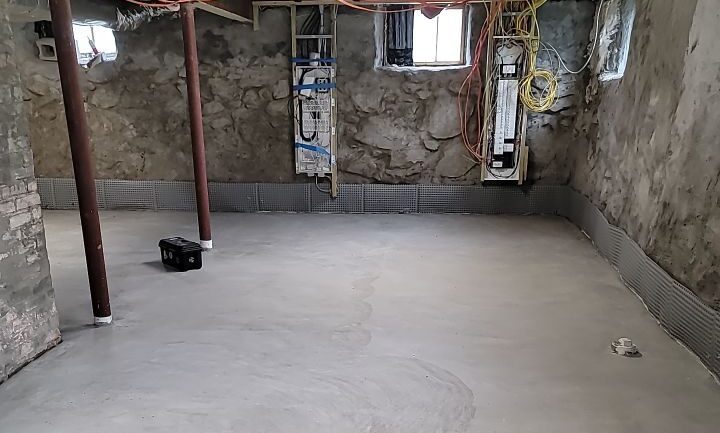Basements are all too often dark, dank spaces, shut away and out of mind. Most of us use them for storage and, let’s be honest, they’re not even great for that. Problems like condensation in the basement, leaks and cracks mean that without some effort, they can end up being a bit of a wasted space in your home. But that doesn’t have to be the case.
What would you do with a nice dry basement? The possibilities are nearly endless- a home cinema, gym, workshop or even another bedroom. The question isn’t one of potential; it’s how to keep a basement dry and realize that potential.
Of course, every home is different and that means that every basement will face its own issues. There’s no one-size-fits-all solution to waterproofing. A home which faces problems with humidity and condensation in the basement requires different interventions from one which has issues with water ingress. In most cases, it’ll be a combination of solutions which will finally eliminate moisture in the basement.
So, if you’re wondering how to keep a basement dry, the answer is: “it depends”.
Identify the Source of Moisture
Eliminating moisture from your basement and building the underground room of your dreams starts with a little detective work. Working out where the moisture is coming from is the first step towards working out how to keep a basement dry.
Condensation Vs Water Seepage
There are two major categories of moisture that threaten our basements. These are water finding its way in from outside and water condensing on the walls from inside.
Condensation
Basements tend to be poorly ventilated. This means that the natural humidity in the air can become trapped and builds up over time. When it hits the cold walls (which are generally underground, so not warmed by the sun) this moisture condenses.
Water Seepage
The ground around your home will always contain a certain amount of water. If there are cracks, even microscopic ones, or changes in this water level after heavy rain, that water can find its way in. Likewise, basements often contain a fair amount of plumbing and appliances. Sometimes these leak, leading to a soggy basement.
Signs To Watch For
Whatever the cause, there are a few tell-tale signs that your basement is facing issues with its waterproofing. Noticing these is the first step towards eliminating moisture from your basement and keeping it dry. Keep an eye out for things like:
- Musty Smells: It’s hard to describe “musty” in words, but you’ll know it when it hits your nostrils.
- Mold: Black spots and fuzz growing on surfaces, especially porous ones. Mold thrives in damp conditions.
- Water stains: That characteristic discoloring is a sure sign that something has gotten wet. That water has to have come from somewhere.
- Dampness: Sometimes you’ll be able to physically feel the moisture. If you run a finger along a wall and it feels clammy, there’s an issue.
It’s also worth being aware of any cracks or signs of efflorescence. Once you’ve discovered the symptom, you should be able to trace it back to the root cause fairly easily.
How To keep A Basement Dry: Interior Waterproofing Solutions
Often, the simplest and least disruptive solutions to keeping water out take place within the basement itself. There are a wide range of interior solutions for eliminating moisture from your basement.
Sump Pumps
As we mentioned before, the soil around and under your home always contains a certain amount of moisture. When it rains, this level increases. Sump pumps offer a handy way of managing this level and ensuring that your basement floor is not threatened.
A sump pump is placed into a small pit (the ‘sump’) below your basement floor. When this pit fills with water, a float switch is activated, turning on an impellor. This creates an area of negative pressure, forcing the water down the discharge line and away from your home. The sump is also a good place to discharge French drains, cove diverters and other internal solutions.
French Drains
Interior French drains consist of a perforated drain pipe, buried just below the floor of your basement. They work by providing an easy path for water to flow from problem areas (i.e. your foundation walls) to somewhere less dangerous.
Water enters through the perforations and then flows along the pipe, either out of your home or into your sump pump. They can help alleviate all kinds of waterproofing issues and reduce hydrostatic pressure.
Crack Sealing
It goes without saying that fixing up cracks blocks a major source of water intrusion. Not all cracks are a threat, but they’re all worth keeping a close eye on.
The general rule of thumb is that if it’s bigger than 1/8th” or damp, it needs to be filled. There are DIY solutions which involve using resins to fill the cracks but larger jobs are best left to the pros.
Vapor Barriers
A vapor barrier is to all intents and purposes a waterproof sheet which is pinned to your walls and placed under floors. There are various types on the market but the most common are effectively sheets of plastic which physically stop moisture from penetrating past them.
They can be hung behind drywall and installed under concrete slabs, allowing you to create a nice finished room.
External Solutions
Sometimes you need to break out the big guns in the quest to eliminate moisture from your basement. While there is no doubting the effectiveness of exterior solutions, they do come with a cost in terms of disruption as they generally involve a certain level of digging (with one exception).
Gutters and Downspouts
While it may be counterintuitive, dealing with your roof is probably the easiest way to help waterproof your basement. Gutters and downspouts ensure that rainwater is conducted away from your home safely and never threatens your basement.
Keep them clear of leaves and ensure that water flows cleanly away.
Proper Grading
Your home should have a gentle slope leading away from the walls. Because water always runs downhill, this helps to alleviate the pressure placed on your foundation walls from groundwater.
There’s no escaping the fact that rectifying poor grading is a disruptive process, but it’s certainly very effective.
Waterproof Coatings And Membranes
While it will require some serious excavation, ‘wrapping’ your foundation in waterproof membranes or applying waterproof coatings can be very effective. These create a physical barrier which blocks water ingress.
Exterior French Drains
Just like their interior cousins, exterior French drains can be a great tool for eliminating moisture from your basement. They can be installed along the exterior walls, hugely reducing the amount of groundwater which pools there and conducting it harmlessly away.
They can also be used to help deal with waterlogged grass or areas prone to forming puddles too.
Controlling Humidity Within the Home
Of course, not all water-related problems come from outside. If you’re facing condensation in the basement, controlling humidity will play a key role in answering how to keep a basement dry.
There are three main things to do here:
- Install a dehumidifier: These ‘suck’ the moisture from the air and allow you to keep moisture levels right.
- Insulate cold surfaces: Condensation forms when moist air hits a cold surface. Insulation reduces this effect massively.
- Increase ventilation: Open doors and windows regularly or even consider installing extractor fans. This avoids humid air getting trapped in your basement.
Routine Maintenance
Even once you’ve answered the how to keep your basement dry question, the work isn’t over. This is a constant battle against the elements. Luckily, once the main issues are dealt with, it’s mostly a case of keeping an eye on things and intervening early when things go wrong.
Regularly inspect your basement for signs of waterproofing issues. This could be the formation or spreading of cracks or signs of mold and mildew. While you’re at it keep an eye on your plumbing and appliances.
Clean out your gutters and ensure that they’re working properly a couple of times a year. This is particularly important in the fall as leaves often gather here.
If you have a sump pump, test it regularly and consider installing a battery backup. It’s particularly important to do this before heavy rains.
How To Keep A Basement Dry: Long Term Solutions
To get the most out of your nice dry basement, it’s important to tackle the root issues rather than just the symptoms.
Installing backup systems, like generators and batteries for sump pumps means that you can rest assured that they’ll work when you need them too. Ensuring doors and windows (which are effectively holes in your walls, after all) are properly sealed can work wonders without blowing your budget.
In the majority of cases, homes can benefit from a mixture of work and what you choose to do is up to your unique situation.

